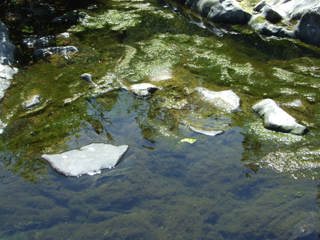
“Linking water,
science, and people”

Using Algae as a Bioindicator
Sierra Streams is proud to be on the cutting edge of biological monitoring with the
establishment of a phytoplankton (algae and diatom) sampling and identification
program. These microscopic living organisms serve as an additional bioindicator of
stream health. As with macroinvertebrates, the presence or absence of phytoplankton
that are intolerant to pollution reveals much about the health of an ecosystem. A
monitoring program that uses a variety of bioindicators is able to provide a more
comprehensive picture of overall health
We are working with the state's SWAMP program to implement and refine newly developed
protocols for phytoplankton sampling. Sampling began in Deer Creek in 2010 and will
continue monthly from May to October each year at all our monitoring sites. Beginning
with diatoms, our staff scientists have begun to identify the organisms found in the
initial samples and to develop an identification key in the style of The Bug Book.
This preliminary identification work marks the beginning of such efforts on the west
coast, and as such provides a critical foundation for future phytoplankton
identification by watershed groups and others throughout the region. Scientific
leadership of this type is at the core of Sierra Streams' mission.

Summer algal growth in lower Deer Creek.
In general, this growth of algae an be attributed to a combination of low stream flows, warm
temperatures, lots of sunlight, and high nutrient inputs from the Lake Wildwood
Wastewater Treatment Plant.
Phytoplankton are at the base of the food chain, feeding on bacteria and nutrients. For this
reason, we are also interested in the presence of invasive
non-native algal species and their effect on biological diversity and on the rest of the
food chain. Sierra Streams scientists are also studying phytoplankton as part of
the transport mechanism for mercury.
By analyzing the mercury content of phytoplankton samples, we
can determine the ability of different varieties to uptake mercury and the extent to
which it is available for downstream transport over dams.




